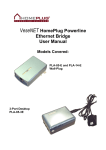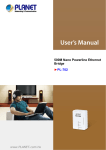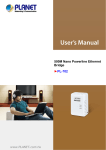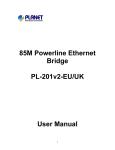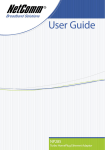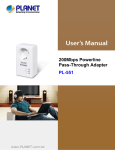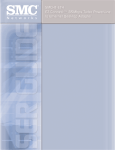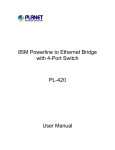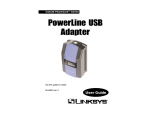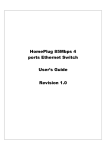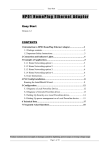Download HEB01 ethernet bridge manual
Transcript
HomePlug Turbo Powerline Ethernet Bridge User Manual Copyright The contents of this publication may not be reproduced in any part of as a whole, stored, transcribed in an information retrieval system, translated into any language, or transmitted in any form or by any means, mechanical, magnetic, electronic, optical, photocopying, manual, or otherwise, without prior written permission. Trademarks All product, company, and brand names are trademarks or registered trademarks of their respective companies. They are used for identification purpose only. Specifications are subject to be charged without prior notice. FCC Interference Statement This equipment has been tested and found to comply with the limits for a Class B digital device pursuant to Part 15 of the FCC Rules. These limits are designed to provide reasonable protection against radio interference in a commercial environment. This equipment can generate, use and radiate radio frequency energy and, if not installed and used in accordance with the instructions in this manual, it may cause harmful interference to radio communications. Operation of this equipment in a residential area is likely to cause interference, in which case the user, at his own expense, will b required to take whatever measure are necessary to correct the interference. 2 Table of Content Chapter 1: Introduction to the HomePlug Turbo Ethernet Bridge……..5 Overview.....................................................................................5 Features……………………………………………………………...5 System Requirements………………………………………………6 Panel………………………………………………………………….6 Chapter 2: Installation..............................................................................7 Overview……………………………………………………………...7 Running the InstallShield Wizard…………………………………..7 Chapter 3: Configuration.......................................................................13 Overview…………………………………………………………….13 Diagnose Powerline Network……………………………………..13 Part 1: Diagnose a local HomePlug device…………………13 Part 2: Diagnose a Network HomePlug device……………..14 Setting up Security on a Local HomePlug device……………….15 Setting up Security on a Network HomePlug device……………16 Appendix A: Troubleshooting……………………………………………..17 Appendix B: IP Addressing………………………………………………...20 What’s an IP address?..............................................................20 Dynamic IP addressing……………………………………………20 Static IP addressing………………………………………………..20 Checking IP addresses (Win 98SE /ME /2000 / XP)……………..21 Setup Static IP addresses………………………………………...23 Part 1: Win 98SE / ME……………………………………..23 Part 2: Win 2000/ XP……………………………………….26 Release and Renew an IP address……………………………..30 Part 1: Win 98SE / ME……………………………………...30 Part 2: Win 2000/ XP………………………………………..33 Appendix C: Local Area Network………………………………………. 36 Sharing Files (Win 98SE / ME / 2000 / XP)……………………….36 Part 1: Sharing Folders ……………………………………...36 Part 2: Sharing Drives……………………………………….39 Part 3: Accessing Other Computers Shared Files…………...42 3 Sharing Printers (Win 98SE / ME /2000 / XP)…………………..45 Part 1: Setup print server………………………………45 Part 2: Network Printer Installation……………………47 Access Internet…………………………………………………….52 Part 1: Win 98SE / ME…………………………………..52 Part 2: Win 2000 / XP……………………………………55 Appendix D: Glossary………………………………………………………59 4 Chapter 1: Introduction to the HomePlug Turbo Powerline Ethernet Bridge Overview Thank you on the purchase of the HomePlug products. Most of us don’t enjoy buying long and expensive Ethernet cables or pulling the cables from one place to another, but this HomePlug Turbo Bridge is one of the easiest ways to enjoy home or small business networking. Users can now experience a total network solution with the HomePlug Ethernet. The HomePlug Turbo Ethernet Bridge operates on the HomePlug Powerline Specification 1.0 Turbo standard, providing up to 85Mbps bandwidth over home AC wiring. Since the home power lines are the most pervasive medium in households with multiple outlets in every room, the HomePlug Turbo Ethernet Bridge allows multiple home desktops and notebooks to be networked to share internet connection, printers, files, and play games without any additional wiring. The installation of the Ethernet Bridge only requires that a 10/100Mbps Network Adapter is installed on the computers. This makes the HomePlug Turbo Ethernet Bridge compatible with any device including Mac, Windows, and UNIX machines. For security, all HomePlug devices are equipped with 56-bit DES encryption. The private home power grid plus encryption makes HomePlug significantly more secure than competing technologies. The HomePlug Turbo Ethernet Bridge is the best solution for No-New-Wires home Networking. With easy Plug and Play installation, and the reliability of Ethernet’s products, the HomePlug Turbo Ethernet Bridge is the best solution for high speed networking. Features • • • • • • • • Up to 85 Mbps bandwidth over standard home power lines Estimated range of 300 meters in wall power lines No problem for the HomePlug signal passing through circuit breaker 56-bit DES encryption assure data security Encryption done by hardware, with no sacrifice on bandwidth Uses IEEE802.3 computer interface Plug-and-Play installation HomePlug Powerline Specification 1.0 Turbo compliant 5 Package Contents • • • • • • 1 HomePlug Turbo Powerline Ethernet Bridge Unit 1 HomePlug Quick Start 1 HomePlug User Manual 1 Installation CD 1 Power Cable 1 CAT5/RJ45 Ethernet cable System Requirements • • • • • At least 2 HomePlug devices Available Ethernet port each computer or network Available empty power outlet Standard home power line wiring CD-ROM drive Panel Front PWR: On Off On Off Receive Power Did not receive Power HP: Detect other HomePlug devices on the same powerline network Did not detect any other HomePlug devices on the same powerline network Eth LED(Act / Link for Ethernet): Blinking: Ethernet activity Lit: detect Ethernet connection Back 6 Chapter 2: Installation Overview The installation of the HomePlug Turbo Ethernet Bridge will only take minutes. No setting up for long wires through out the house. Just simply install the software CD that is included in the box and after installation, physically plug the unit into the computer and the wall outlet. Users will have options to adjust its security functions and the platform of the network once everything is installed properly. For further assistance, please read our Frequently Asked Questions section. Running the InstallShield Wizard Please insert the CD into your CD-ROM and wait a moment for the setup screen to come up. If the CD-ROM does not auto run the CD, please click on ‘Start’ at the bottom left of your screen (for most Microsoft Windows) and go to ‘Run’. Type in: (CD Drive Letter):\eth\setup.exe and click ‘OK’ Once the software is loaded it will display a dialog such as is: Please click on ‘Next’ to continue the installation. 7 On this screen you will be asked to input the User Name and Organization. It is not crucial to the device itself so enter as desired. The ‘Install this application for’ will work under the circumstances which multiple logins are applied. For example: If the user wishes only he/she can use the utility with that particular account, then bubble in ‘Only for me’. For those without multiple accounts or wishes to allow all users to access the utility choose ‘Anyone who uses this computer (all users)’. When finished, click the ‘Next’ button to continue. This section allows you to change the default directory where the program is installed. If you don’t want to change the directory click on Next to continue the installation process. 8 This section allows a user to go ‘Back’ or ‘Install’ the utility. In case if the user wishes to change the previous options then go ahead and click on ‘Back’ to change the settings. If not, continue and click the ‘Install’ button. This screen shows the progress of the installation. 9 This screen shows that the installation was completed successfully. Click on Finish to exit the wizard. Now its time to setup you hardware connections please refer to the next diagrams. Plug your network cable into the computer’s RJ-45 network adapter port 10 Plug the other end of your network cable into the RJ-45 port locate at the back of the HomePlug Turbo Ethernet Bridge Plug your power connector of your power cable into the power connector at the back of the HomePlug Turbo Ethernet Bridge 11 Plug the power plug of your power cable directly into a power outlet on the wall **Note: ** Do not plug the device into a UPS or power strip with surge protection. The HomePlug Turbo Ethernet Bridge has its own power filter for protection against surges. 12 Chapter 3: Configuration Overview The HomePlug device uses 56-bit DES encryption to block outside access. The key is set by using the HomePlug Configuration Utility on the CD. By default, the protection is enabled. However, it is recommended that you change the default network password. All your HomePlug devices must use the same network password in order for the computers to be networked. Make sure that all devices are loaded with the same network password. Diagnose Powerline network Part 1: Diagnose a Local HomePlug Device Double click the PowerPacket Utility icon on your desktop to open this utility show in the screen below: The Main tab shows the HomePlug units that are connected to the current computer and oter devices on the network. It will also tell Mac Address of each device. It will let you refresh the window, if you change devices, and also will allow you to connect to different networks if multiple units are connected to your computer. 13 *Note* If the Link Quality is poor, and appears red, or the Mac Address of any of the units connected to this computer appears to be all 0’s, then you might have a defective unit. Please contact technical support (Appendix G) ** *Note* If you do not see ANY unit in the device status, and there is a device connected to your computer, try to unplug all devices, and plug them back in. Also make sure that the cable connecting your computer to the HomePlug device is the right type and working correctly. If all of this seems to be correct, and you still receive nothing in the Device window, try rebooting your computer. If the problem still persists, please contact technical support (Appendix G). Part 2: Diagnose a Network HomePlug device The Main tab shows all the other HomePlug Units on your powerline network. It will represent them by MAC Address, and will also show the available bandwidth to each unit (Units farther away from the current computer might have a lower Data Rate, since the distance is farther). If you add or subtract units from your home network, you might want to reScan, by clicking the “Scan” button. This will rescan the network, and refresh with any changes. **Note** Only units with the same Network Password will be shown, please check that first, to make sure they all have the same network password (Case sensitive). 14 **Note** If a Unit shows MAC Address of all 0’s, this unit might not have a solid connection, or might not connect at all. If this is the case please contact technical support (Appendix G). **Note** If there are Units in your home, that you do not see in this Network scan, try to unplug all devices, and plug them back in (Only do this with the Units that you do not view in the network screen, you don’t have to do this with all units. If the problem persists, try to move the unit closer to this current unit (adjacent plugs on the same wall socket is most preferable). If the problem still persists and that unit is still not shown on the network, then the unit might be defective please contact technical support (Appendix G). Otherwise if you view the unit working, distance might be the only issue. Setting Up Security on a Local HomePlug device The Privacy tab will allow you to change the Network Password to the unit that is currently connected to this computer. This network password encrypts all data that is sent from this unit using 56-bit data encryption standard (DES). The DES Encryption is very secure, and very difficult to crack, therefore your home network is very secure, and very difficult to breach your home network. **Note** Every unit on your home network MUST have the same Network Password for connectivity to be established throughout your home. The default network password is “HomePlug”. 15 Setting Up Security on a Network HomePlug device The Privacy Tab will allow users to use one primary computer to control the Network Password of all units on the home network. You will have to go back to the Main Tab first then find the DEK (Device Encryption Key) Key located on the bottom of each device. Enter this Key into the Device Password area. Click Add. This Device Key will then appear in the bottom window . Add all the DEK Keys for each unit in your house. You can now go back to the Main Tab then change the password remotely from one computer. This will allow you to change the password from one computer, instead of changing the password individually. **Note** The DEK is unique for EACH HomePlug device. To use this you will need to input the DEK for each unit. 16 Appendix A: Troubleshooting Frequently Asked Questions Q. What’s the speed of HomePlug operate over a standard home power line network? A. HomePlug operates up to 85 Mbps bandwidth over a standard home power line network. Q. What’s the Estimated Range of HomePlug? A. Approximately 300 meters in wall power lines (one household). Q. Will HomePlug work in any home? A. Any home with copper wiring built-in, since some of the older houses built before 1950 might have older wiring, it may not work in these instances.. Q. Will HomePlug signal pass through circuit breakers? A. Yes, HomePlug signal will have no problem passing through circuit breakers but not through power transformers. Q. Does Homeplug work with AC input 100 – 240V? A. Yes, HomePlug works with AC input 100 – 240V. Q. Does HomePlug cause any interference with other my other home networking device? A. No, HomePlug operates in a different frequency band than other power line control devices and can co-exist with technologies as X-10, CEBus, and LONworks. Q. Can my neighbor receive my HomePlug signal? A. It is possible for your neighbor receive your HomePlug signal between two adjacent homes. To prevent this happen, please enable the 56-bit DES security encryption on your HomePlug Device. To do that, you must run the HomePlug Configuration Utility on each Homeplug device in your power line network. This will only allow computers with the same security password to be able to receive information. 17 Q. How do I find out what’s my current speed and my signal strength of my HomePlug device? A. Run the HomePlug Configuration Utility, it will show your current speed and your signal strength. Q. One of the Powerline LED’s doesn’t light up after I plug the HomePlug directly into a wall outlet? A. Test that wall outlet with other electric devices first, make sure that wall outlet is working properly. Then, try to plug your HomePlug device again, if the same problem happens again, plug both HomePlug units into adjacent sockets, and see if the lights light up. If you are still having problems please contact Technical Support (Appendix G). Q. The Ethernet LED doesn’t light up on my HomePlug Turbo Ethernet Bridge? A. Most likely, if the Ethernet LED doesn’t light on your HomePlug Turbo Ethernet Bridge is because the Ethernet port on it doesn’t detect a LAN connection. Check your Ethernet adapter on your computer, and make sure its enable and working properly. Also, check your Ethernet cable, make sure you use the right type, it’s plugged in correctly, and it’s working properly. Q. I can’t connect to internet and other computers on my power line network? A. 1. Check your IP address and TCP/IP protocol are set up properly for all the computers on your power line network (Appendix B) and try to ping your gateway (Appendix B). 2. See if HomePlug Configuration Utility to detect all other HomePlug device on your power line network. Try plugging both HomePlug units into Adjacent sockets and see if the lights light up. If you are still having a problem, please contact Technical Support (Appendix G). Q. How many HomePlug devices do I need to setup a powerline network? A. You must need two or more HomePlug devices to setup a powerline network. Q. In order to making the HomePlug Turbo Ethernet Bridge working properly, do I have to install the HomePlug Configuration Utility on every single computer who has the HomePlug Turbo Ethernet Bridge plug into it? A. No, the HomePlug Configuration Utility is a utility to diagnose or setup encryption for HomePlug device. Due to HomePlug Turbo Ethernet 18 Bridge is a fully plug & play device, no driver require to install. So technically speaking, the HomePlug Configuration utility is not a requirement to install on your computer. In other words, you can install the utility, setup the encryption, and delete it from your computer, but your HomePlug Turbo Ethernet Bridge will still working properly. Q. How many HomePlug Turbo Ethernet Bridges that I can install into one same Local Area Network? A. It recommended install up to 16 HomePlug Turbo Ethernet Bridges in one same password powerline network. 19 Appendix B: IP Addressing What is an IP Addresses? IP Stands for Internet Protocol. An IP Address is the identifier where other computers on the network can contact your computer, when you are connected to the network using the TCP/IP protocols. The format of IP addresses are 32bit numerical addresses in 4 groups of 3. It is ranged from 0-255. For example: 255.255.255.255. This number allows your computer to be unique on the same network, and able to communicate with other computers on the network. Dynamic IP Addressing Dynamic IP Addressing is where the computer will automatically be assigned a new IP Address. This IP Address will be unique to the network that it is working on, and should not be the same as any other computer on the same network. Static IP Addressing Static IP Addressing is where the computer will have a preconfigured IP Address. This Address will never change, and will always be the same. This scheme should be used if you want to keep the same settings on each computer all the time. If the subnet of the network changes (subnet is the first 3 groups of the IP) the subnet of the static computer must also change. 20 Checking IP Address (Windows 98SE/ ME/ 2000 / XP) 1. Click Start and click Run 2. Type “Command” in the run prompt, Click OK 21 3. A Dos Command prompt will open. Type in “ipconfig” and press Enter 4. Your IP Address will Display, along with the Subnet Mask, and your Gateway 22 Setting Static IP Address Part 1: Windows 98 SE / ME 1. Right Click on “Network Neighborhood” and click “Properties” 23 2. Click on “TCP/IP” for the network adapter you want to set IP addresses for 3. Click on “Specify an IP address” Type in the IP Address you wish to use. (192.168.XXX.XXX is very standard for home networks) Click on the Subnet mask, and if you know the subnet mask you want to use, type it in, otherwise it should fill in with “255.255.255.0” which is very standard for subnet masks. 24 4. Click on the “Gateway” tab, and add in your gateway IP address. 5. Click on the “DNS Configuration” tab, and add in your DNS server IP address. Click OK button when you done. 25 5. To save the changes you must restart, so click “YES” Part 2: Windows 2000 / XP 1. Right click My Network Places and click Properties. 26 2. Find and “Double Click” the Local Area Connection for the Network adapter you want to Set IP’s for. 3. Click Properties 27 4. Click(Highlight) “Internet Protocol (TCP/IP)” and click “Properties” 5. Click “Use the following IP address” Type in the IP Address you wish to use. (192.168.XXX.XXX is very standard for home networks) Click on the Subnet mask, and if you know the subnet mask you want to use, type it in, otherwise it should fill in with “255.255.255.0” which is very standard for subnet masks. Click on the Default gateway and fill that in. If you know 28 the DNS you are going to use, fill it in otherwise leave it blank. Then click OK. 6. To check that everything is Correct, Click on “Support” and the information you typed in should appear. 29 Release and Renew an IP address Part 1: Windows 98 SE / ME 1. Click Start, then click Run 30 2. Type “winipcfg” and click OK 3. Select the Network adapter you want to release IP’s for. 31 4. Click “Release” 5. Your IP Address should turn to 0.0.0.0 32 6. If you Click Release, and an error saying “IP Address for adapter is already released” then you do not need to release any more, Try “Renewing your IP” Part 2: Windows 2000 / XP 1. Click Start, then click Run 33 2. Type Command and click OK 3. Type “ipconfig /release” and press Enter 34 4. Your IP Address should turn to 0.0.0.0 . To Renew your address check Renewing IP Address. 5. If you receive an Error “The operation failed as no adapter is in the state permissible for this operation.” Then you might need to set your Network adapter to obtain your “IP Address Automatically”. 35 Appendix C: Local Area Network Sharing Files (Windows 98SE / ME / 2000 / XP) Part 1: Sharing Folders 1. Double click “My computer” on your O/S desktop 36 2. Double Click the Drive where the folder that you want to share is located. 3. Right Click on the folder you want to share, and click “Properties” 37 4. Click “If you understand the risk but still want to share the root of the drive, click here” 5. Click “Share this folder on the network” and specify the name you want the folder to be seen as on the network. 38 6. A Hand should appear under the folder you wanted to share letting you know that it is shared on the network. Part 2: Sharing Drives 39 1. Right click on “My Computer” and click “Properties” on your O/S desktop 2. Right click on the drive you want to share and click “Properties” 3. click on the Sharing tab “If you understand the risk but still want to share the root of the drive, click here” 40 4. Click on “Share this folder on the network” and specify what you want your shared folder to be viewed as. 5. A hand should appear under the drive you wanted to share. This lets you know that it is shared on your network 41 Part 3: Accessing Other Computers Shared Files 1. Find the IP Address of the computer you want to access(Look at Check IP) 2. Click Start, and then click Run 42 3. Type “\\” and the IP address of the computer you want to access. (Format is “XXX.XXX.XXX.XXX”) 4. All the files that the computer you are trying to access will open in a new window. 5. An Alternate way to do the same thing is to find the Computer Name of the computer you are trying to access. And typing “\\______” with the computer name in the blank 43 6. All the files that the computer you are trying to access will Open in a new window. 44 Sharing Printers (Windows 98SE / ME / 2000 / XP) Part 1: Setup print server 1. Click “Start” and click ‘Printers and Faxes” 45 2. Right click on the printer you want to share and click “Properties” 3. Click the “Sharing” tab, and click “Share the printer” then specify the name that you want the printer to be seen as on the network. Then click “OK” 4. A hand should appear under the printer you want to share. 46 Part 2: Network Printer Installation 1. Click Start and click on Printers and Faxes. 2. The Printers and Faxes window should open, on the left side there should be an Add a Printer button under Printer Tasks. Click on Add a Printer 47 3. The Add Printer Wizard should appear, click Next to proceed 4. Select “A network printer, or a printer attached to another computer” and click Next 48 5. Click “Browse for a printer”, unless you know the computer name (or IP address) of the printer, and the exact printer name. Or the printer is at a location that can be connected to through the internet. And click Next 6. Browse through your network and select the printer that you want to add, Highlight it, and click Next 49 7. Click Yes to proceed 8. Unless you want this to be your default printer, click NO, otherwise click YES and click Next 50 9. Click Finish to finish the network installation 10. The printer should now be installed on your computer. **Note** You may need to install drivers for the printer you want to install, so make sure you have them available before trying to install any printer. 51 Access Internet Part 1: Windows 98SE / ME 1. Double Click Internet Explorer 2. The Internet Connection Wizard Should open(If this does not open and Internet Explorer Opens up, skip to Section 7) Click “I want to set up my Internet Connection Manually, or I want to connect through a local area network(LAN)” click Next 52 3. Click “I connect through a local area network(LAN)” Click Next 4. Click “Automatic discovery of proxy server(recommended)” Click next 53 5. Unless you want to setup your Email (you can do this separately later) Click NO, and click ‘Next’. 6. Click the box, and click Finish 54 7. You should be on the internet, If a website does not occur Try to Release IP, then Renew IP, and try to Ping your gateway. Part 2: Windows 2000 / XP 1. Double Click on Internet Explorer 55 2. The New Connection Wizard might open(If this does not happen, skip to Step 7) Click Next 3. Click “Connect to the Internet” and click Next 56 4. Click “Set up my connection manually” 5. Click “Connect using a broadband connection that is always on” 57 6. Click Finish 7. You should be on the internet, If a website does not occur Try to Release IP, then Renew IP, and try to Ping your gateway. 58 Appendix D: Glossary Default Password A password set by the manufacturer that is unique to each device and is used to Generate a Default Encryption Key (DEK). The DEK is used only for the purpose of encrypting management commands that change the NEK so that the NEK is never sent in the clear over the powerline. DHCP Dynamic Host Configuration Protocol is a method in which IP addresses are assigned by server dynamically to the clients on the network. DHCP is used for Dynamic IP Addressing and requires a dedicated DHCP server on the network. Encryption Key (EK) 64-bit pattern generated by a key derivation function. An EK is used in an encryption algorithm to add security to transmissions between HomePlug devices in a logical network. Ethernet Ethernet is a 10/100Mbps network that runs over dedicated home/office wiring. Users must be wired to the network at all times to gain access. Gateway A gateway is a hardware and software device that connects two dissimilar systems, such as a LAN and a mainframe. In Internet terminology, a gateway is another name for a router. Generally a gateway is used as a funnel for all traffic to the Internet. IEEE The Institute of Electrical and Electronics Engineers. The IEEE describes itself as “the world’s largest technical professional society—promoting the development and application of electro technology and allied sciences for the benefit of humanity, the advancement of the profession, and the wellbeing of our members.” Local Area Network (LAN) A LAN is a group of computers, each equipped with the appropriate network adapter card connected by cable/air, that share applications, data, and peripherals. All connections are made via cable or wireless media, but a LAN does not use telephone services. It typically spans a single building or campus. Logical Network Two or more HomePlug devices that share a common Network Encryption Key (NEK) and that communicate with encrypted transmissions. 59 Network A network is a system of computers that is connected. Data, files, and messages can be transmitted over this network. Networks may be local or wide area networks. Network Password A password set by the user that generates the NEK and defines the user’s logical network. RJ-45 A connector similar to a telephone connector that holds up to eight wires, used for connecting Ethernet devices. Router Protocol-dependent device that connects subnet works together. Routers are useful in breaking down a very large network into smaller sub networks; they introduce longer delays and typically have much lower throughput rates than bridges. Powerline Networking Data transmission over powerlines. Password Sequence of characters that serves as input to a key derivation function that generates an Encryption Key (EK). Protocol A protocol is a standardized set of rules that specify how a conversation is to take place, including the format, timing, sequencing and/ or error checking. Static IP Addressing A method of assigning IP addresses to clients on the network. In networks with Static IP address, the network administrator manually assigns an IP address to each computer. Once a Static IP address is assigned, a computer uses the same IP address every time it reboots and logs on to the network, unless it is manually changed. Transmission Control Protocol / Internet Protocol (TCP/IP) TCP/IP is the protocol suite developed by the Advanced Research Projects Agency (ARPA). It is widely used in corporate Internet works, because of its superior design for WANs. TCP governs how packet is sequenced for transmission the network. The term “TCP/IP” is often used generically to refer to the entire suite of related protocols. 60 Wide Area Network (WAN) A WAN consists of multiple LANs that are tied together via telephone services and / or fiber optic cabling. WANs may span a city, a state, a country, or even the world. 61





























































